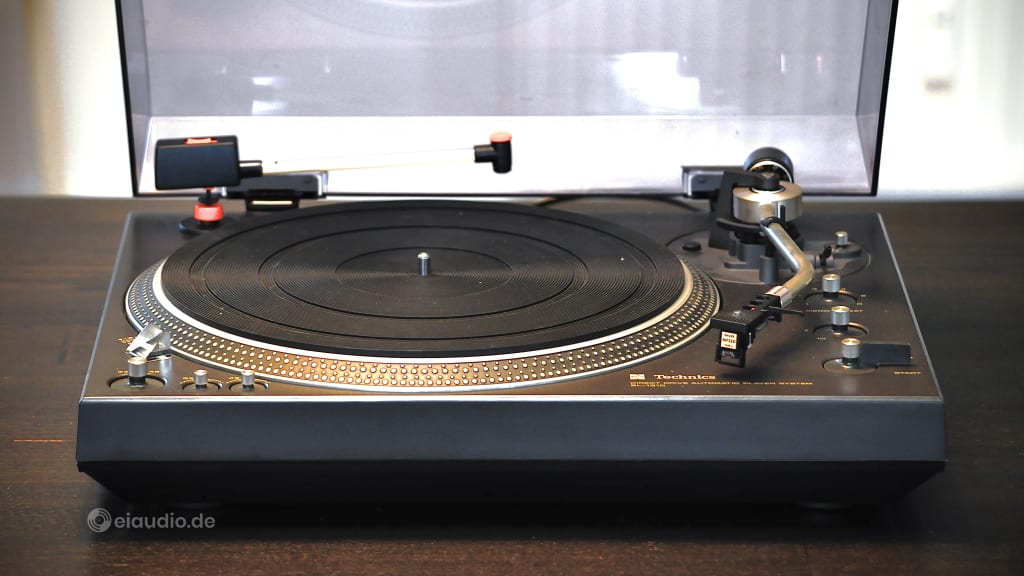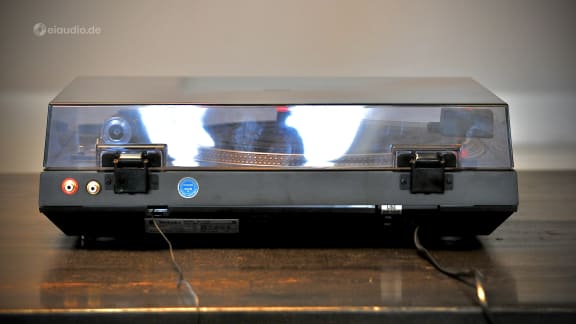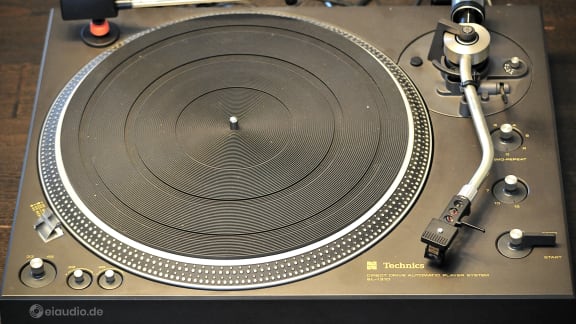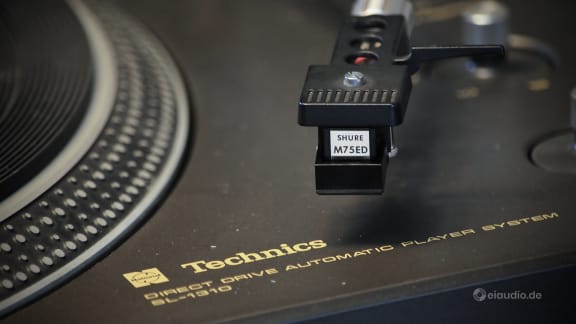Technics SL-1310
Published: 25/04/2021
Manufacturing date: 1975
Author: Karsten Hein
Category: Gear & Review
Tag(s): Turntables
Following the stellar performance of our 1977 Sansui SR-525 direct drive turntable, I began scanning the web for other direct drive contenders from the 70s. And, since Technics had been the company to invent the direct drive concept, I was curious to learn how their turntables compared against the formidable standard set by our Sansui. By the 1970s and 80s, Technics decks had earned a reputation for being at the cutting edge of turntable technology. In addition to introducing and refining the direct drive, a design by which the motor shaft itself serves as the axis of the turntable platter, Technics was also credited with being among the first manufacturers to bring the sophisticated S-shaped tonearm to the mass market. I therefore decided that a Technics deck would be a worthy contender for exploration.
The brand’s most iconic turntable is arguably the SL-1200. To my knowledge, it is also the longest turntable in production. It first came out in October 1972, just one month after I was born, and continued to be in production until 2010. After a six-year break during the vinyl crisis, production resumed in 2016. Although primarily intended as a high fidelity consumer record player, the SL-1200’s superb build quality and high torque motor made it an instant success with radio stations and club disk jockeys. To date, more than 3 million units of this player have been sold. And, considering that it is back in production, we are still counting. Perhaps it is no surprise then, that an SL-1210 turntable is on display at the London Science Museum, as one of the icons that have shaped our modern world.
Since so much had been said and written about the SL-1200, prices for them used were quite high at my time of searching. This was even true for specimens that were in relatively poor shape and had been dragged around clubs, etc. Regardless of the condition, the name alone seemed to validate a higher price. I therefore decided to look for Technics turntables that offered a similarly sophisticated design but were missed by mainstream attention. I soon learned that the Technics 1310 offered much of the same technology that is found on its famous sibling, but this at a far lower price tag. And, due to its mostly domestic use, chances of this player having been dragged from club to club were rather slim. It appeared to me that the major differences between the two decks rested on their ability to absorb chassis resonances, to maintain exact speed in the event of physical force against the platter, and in the stress resistance of their lower chassis. In all these disciplines, the SL-1200 clearly had the upper hand.
And still, the SL-1310 can rightfully be considered an audiophile record player, even if it was not built to be carried around as a professional DJ or radio player. For my intended usage in our domestic environment, the SL-1310 had all the relevant features without the high price tag of its sturdier sibling. I began to narrow my search to the SL-1310 and noticed that cracked lower chassis were the norm rather than the exception. It seemed to me that the combined weight of the aluminium top casing and platter were simply too much weight for the lower plastic chassis to carry, especially when the Technics was moved carelessly. Other specimens had ugly scratches along the front or showed some discolouration of the body paint where they were mostly touched. Some had missing or broken dust covers, faulty mechanisms, or were simply missing the cartridge or stylus. On the positive side, most of these symptoms were relatively easy to spot. I therefore decided that I would focus on SL-1310s that were visually intact and would then see to it that functionality was properly restored.
The specimen that I ended up buying seemed to offer both. Its body and cover were in excellent condition with just a tiny hairline scratch at the front. It was still fitted with the original Shure M75 cartridge and ED stylus, a clear indication that this player had not been used much. There was no damage to the lower plastic body. The price still was relatively high, considering that the player was nearly half a century old, however, I decided to be open-minded during my visit to the owner. If the condition was as described, perhaps the higher price was justified.
Upon arrival, I found the player set up in the basement. It was connected to power but without an audio signal connection. I was informed that the owner had sold all his original HiFi components and moved on to more convenient Bluetooth devices. The SL-1310 was the last remaining item from the glory days of high fidelity. And although he remembered his turntable to have been in working condition when he had stowed it away some seven years earlier, we found that many of the original functions were no longer intact. The automatic cueing did not meet the start of the record. Instead, the stylus landed somewhere between songs, regardless of the disc diameter setting. We managed to set the speed for 33 rpm correctly, but all attempts failed when trying to stabilise the record speed for 45 rpm. A little confused by the number of issues, we estimated the price of repair, and he offered to deduct these costs from the offer price. Under these circumstances, I was happy to agree to the deal.
Upon connecting the Technics at home, I discovered that the player’s left audio channel failed after a few minutes of playing. I managed turn it back on by re-connecting the cinch cable, but shortly after, the left channel failed again. Unlike our Sansui SR-525, all Technics decks of the period came equipped with non-detachable cinch/RCA interconnects, a factor that made it difficult to locate the left channel’s contact issue and also seemed a hindrance to upgrading the sonic ability of the player. I therefore made a list of all defects and added to this the need for proper cinch/RCA sockets to be installed. Luckily, our trusted mechanic for such audio matters had some time available, and I drove by for a visit the next day.
In terms of product innovation, the SL-1310 carried the direct drive concept one step further than the original designs. While most record players of the time, including the Sansui, had their large motors sitting centrally under the platter, a concept that required a certain minimum height, the revised Technics design used the platter itself as rotor and the player’s chassis as the stator. The turntable could therefore have a lower silhouette, used fewer parts, dissipated less heat, lowered electricity consumption to less than 0,1 watts, and decreased resonances. Speed-accuracy was class-leading at the time, at just 0.1% error over 30 min playing time. It is often said that disc-cutting lathes of the time were less accurate than this. Due to the slow-revolving motor, rumble was found mostly outside the relevant frequency band, namely from 20 - 35 Hz. The two peaks measured are at around 22 and 34 Hz. And of course, the iconic Technics platter showed a wide tapered rim with strobe markings for 33-1/3 and 45 rpm synchronisation at 50 or 60 Hz, i.e. four dotted lines in total.
As it turned out, our SL-1310 was mostly suffering from corrosion to the switches that had accumulated over the years. This was most likely facilitated by moisture while being stored in the basement. We discovered that most switches could be taken apart to be serviced. Only one of them, the one to set the record size, was beyond repair and needed replacement. Two holes were bored into the back of the turntable to hold the new cinch/RCA sockets. This step enabled me to use my own interconnects with this player, a seemingly small improvement but with a major impact on sound. The faulty left channel turned out to be caused by a loose connection inside the Shure cartridge itself. It was decided that we would heat the relevant pin with a soldering iron, until we could push the pin a few millimetres into the cartridge housing. The trick worked, and both channels played music again.
Back at home, I connected the Technics SL-1310 to our office system and was very pleased with the way it performed and handled. I set the 'Memo-Repeat' dial to 'three (3)' and the platter started spinning silently. I then pulled the lever downwards to the 'Start' position. The player reacted by gently lifting the tonearm and setting it down at the start of the first title. I noticed that the placing of the needle could have been a bit gentler, perhaps. However, the small thump it produced was still within reasonable limits. The Shure M75 with elliptical stylus used to be a mid-market cartridge back in the day and could not rival the Shure V15 that was found as standard on German-made High End Dual turntables. However, in typical Shure fashion, the M75 ED put forth a warm and delicate sound with long-trailing decay. It may not have exhibited the bass-slam of the Shure 6S, but it did play accurately and endearingly. It seemed to me that upgrading to the V15 cartridge, perhaps with a Jico replacement stylus would be a welcome but costly alternative for a later day.
The Technics SL-1310 itself could certainly do with some additional decoupling of the chassis. Right from the start, I noticed that any touching of the rack had a similar popping effect as the touching of a microphone. This effect vanished completely, after I placed the Technics on four Oehlbach isolation pads. Since the player is rather heavy with its aluminium platter and aluminium top-chassis, it remains wonderfully stable, despite the inherent softness of the pads. Among the features that I enjoy most about this player are its automatic functions that keep me from having to crawl into the small space under the slope of the roof where our system stands, and its life-like three-dimensional presentation of the music. Paired with our Hafler XL-280 power amp and Tannoy speakers, a deep holographic image of the stage is projected into the room right in front of me. Not bad at all, especially for a deck that is nearly half a century old.
Specifications
-
Type: fully automatic direct drive turntable
-
Platter: 312 mm aluminium diecast
-
Speeds: 33 and 45 rpm
-
Motor: ultra-low speed, brushless DC
-
Motor Power Consumption: < 0,1 Watts
-
Wow and flutter: < 0.03% WRMS
-
Rumble: - 70 dB
-
Tonearm: S-shaped, tubular, 4-pin connector
-
Effective length: 230 mm
-
Effective mass: 23g (incl. 6g cartridge)
-
Effective length: 230 mm
-
Tracking force adjustment: 0,25 to 3g by 0.1g
-
Cartridge weight range: 4,5 - 9g
-
Dimensions: (W) 430 x (H) 130 x (D) 375 mm
-
Power consumption: 8,0 Watts
-
Power Supply: AC 110 - 240V, 50/60 Hz
-
Weight: 9,4 kg
-
Year(s): 1975 - 1977





